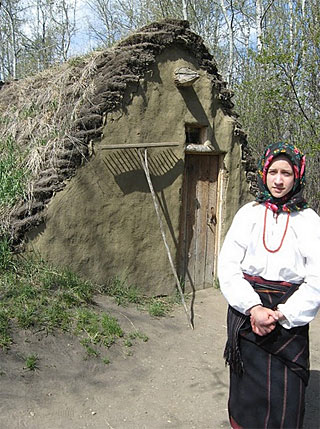Burdei Homes
The first order of business for any pioneer family was to make
sure that they had shelter. In the Ukraine, some of the very first
houses were simple huts that were made from sod and logs. The
name for this structure was "burdei."
 Burdei Home
Burdei Home |
|
To build a burdei, first the brush and trees needed to be cleared
from the land. The brush was burned, and the branches and bark
were removed from the harvested trees. Then a hole was dug in
the ground, and the logs were leaned together in an "A"
shape.
Sod would then be cut from
the earth, and used as a covering for the logs.
In this way, the roof was formed. The gaps in the logs were filled
with clay. Now the pioneer family was ready for winter.
Ukrainian immigrants to Canada constructed their first homes
from logs. They used clay to coat the walls in order to keep the
wind at bay. They thatched the roofs. To brighten the house, they
used whitewash on the exterior and interior walls. Many homes
consisted of only one room, with the door and the windows facing
south. Often there was no chimney. A clay oven was used for cooking
and warmth, and a pipe was used to vent the smoke.
A burdei is actually a sort
of hybrid of a log cabin and sod house. It is half-dugout,
and may have a wooden floor. Many cultures had burdeis. Neolithic
burdeis were typically elliptical-shaped, with the roof just slightly
above the ground. The Grubenhaus was a type of burdei that was
common in the Carpathians and on the Lower Danube in the 6th and
7th centuries.

Burdei House
It was typically built over a pit that was rectangular, and had
a floor area of between four and twenty-five square meters. The
Russians used the term "Poluzemlianki" to describe a
structure that is dug partly into the ground, often at a depth
of less than one meter. In Eastern Europe, burdeis were often
used as permanent housing.
Mennonite immigrants from
Imperial Russia who settled in Kansas built burdeis
to serve as temporary shelter. This type of dwelling was also
called a zemlyanka, or saraj (which is Low German spelling for
the Russian word for "shed"). They were cheap but comfortable,
consisting of a simple skeleton roof that was constructed on the
ground using little timber.
The skeleton roof was created on the ground, and then was thatched
with grass from the prairie. People and livestock alike lived
in these structures, separated by a partition made of adobe.
Conclusion
Building a burdei could be time-consuming. First the site needed
to be excavated. Then there were tasks like binding sticks on
trusses, and cutting and transporting trees. At least two people
would be needed to complete the job. A good deal of wood and clay
was required, and reeds had to be harvested to cover the structure.
The entire operation could take nearly a month, assuming work
weeks of between sixty and seventy hours.
|

